
Belgrano is a northern and leafy barrio or neighborhood of Buenos Aires, Argentina.

Balvanera is a barrio or neighborhood of Buenos Aires, Argentina.

Núñez is a barrio or neighbourhood of Buenos Aires, Argentina. It is on the northern edge of the city on the banks of the Rio de la Plata. The barrio of Belgrano is to the southeast; Saavedra and Coghlan are to the west; and Vicente López, in Buenos Aires Province, is to the north.

Villa Urquiza is a barrio or neighborhood of Buenos Aires, Argentina. It is located between the barrios of Villa Pueyrredón, Belgrano, Villa Ortúzar, Coghlan, Saavedra and Agronomía. Its limits are the streets and avenues Constituyentes, Crisólogo Larralde, Galván, Núñez, Tronador, Roosevelt, Rómulo S. Naón and La Pampa.

Coghlan is a barrio (neighbourhood), of the city of Buenos Aires, Argentina.
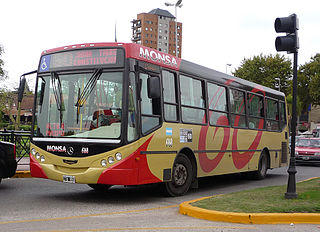
The Colectivo 60 commenced operations in 1931 and runs from Constitución station, in the centre of the city of Buenos Aires, Argentina to the Tigre Club in the partido of Tigre. The service is operated by Transportes Larrazabal C.I.S.A, DOTA and MOTSA and the identifying colour of the buses is white and red with black details.

Constitución is a barrio or neighborhood of Buenos Aires, Argentina, approximately two kilometers south of downtown.
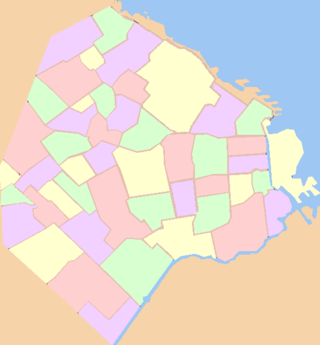
Buenos Aires, autonomous city and capital of Argentina, is composed of forty-eight neighborhoods. Since 2008, the city is also legally divided into communes, each one including one or more barrios. Among the most visited and populated barrios are Palermo, Recoleta, Puerto Madero, Belgrano, San Telmo, La Boca, Monserrat and Caballito. Sectors of the city are also traditionally known as neighborhoods by the inhabitants of Buenos Aires, but not officially by the authorities of the city; some examples include Chinatown, Barrio Norte and the Microcentro.

Liniers is a barrio (neighborhood) of Buenos Aires on the edge of the city, centered on Rivadavia Avenue. It is also an important train station and bus hub, connecting western Gran Buenos Aires with the Buenos Aires Metro.

Villa Devoto is a neighborhood or district located in the northwestern area of the city of Buenos Aires, Argentina. Its administrative limits are defined by Lope de Vega, General Paz, San Martín, and Francisco Beiró Avenues; and Joaquín V. González, Baigorría, and Campana streets.
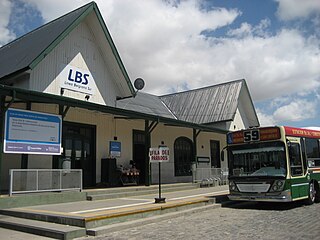
Buenos Aires is a former passenger railway station in the city of Buenos Aires, Argentina. The station was terminus of the Belgrano Sur line that runs trains along Greater Buenos Aires region.

Flores is a middle-class barrio or district in the center part of Buenos Aires city, Argentina. Flores was considered a rural area of the Province of Buenos Aires until 1888 when it was integrated into the city. Flores is the birthplace of Pope Francis.

Ciudadela is a city in Greater Buenos Aires, Buenos Aires Province, Argentina. It is located in the Tres de Febrero Partido, immediately to the west of the neighborhood of Liniers in Buenos Aires city proper. It is separated from the city by General Paz avenue.

Vélez Sársfield is a barrio or district in the western part of Buenos Aires, Argentina, located in the area defined by the streets Segurola Avenue, Juan Agustín García, Lope de Vega Avenue, Juan B. Justo Ave., Corro Ave., Medina, Juan Bautista Alberdi Ave. and Mariano Acosta.
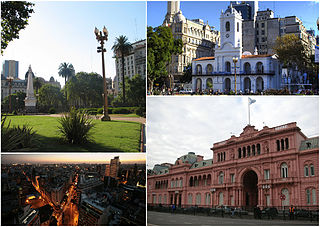
Monserrat or Montserrat is a neighbourhood in the east of the Buenos Aires CBD. The district features some of the most important public buildings in Buenos Aires, including city hall, the city legislature, Casa Rosada, the Colegio Nacional de Buenos Aires and the Libertador Building, among others.

Villa Lugano is a barrio (neighbourhood) in Buenos Aires, Argentina, located in the south of the city. It has a population of approximately 114,000 people. It is delimited by Avenida Eva Perón, Avenida General Paz, Calle José Barros Pazos, Avenida Lisandro de la Torre, Avenida Coronel Roca and Avenida Escalada. To the south-east it limits with La Matanza Partido.

Puente Alsina is an Argentine railway station in the Greater Buenos Aires neighbourhood of Valentín Alsina in the Lanús partido of Buenos Aires Province. The station takes its name from the nearby bridge of Puente Alsina over the Riachuelo River. On the other side of this bridge lies the neighbourhood of Nueva Pompeya within the city of Buenos Aires.
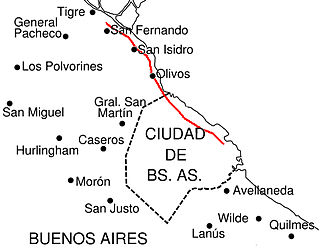
Avenida del Libertador is one of the principal thoroughfares in Buenos Aires, Argentina, and in points north, extending 25 km (16 mi) from the Retiro District of Buenos Aires to the northern suburb of San Fernando.

Retiro bus station is the main bus terminal in Buenos Aires, Argentina. It is situated in the Retiro district, two blocks north of Retiro railway station.

The Central Station was a railway station in the city of Buenos Aires, Argentina, which operated from 1872 to 1897.





















